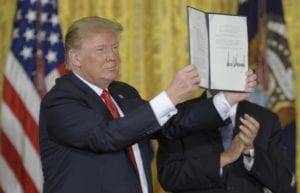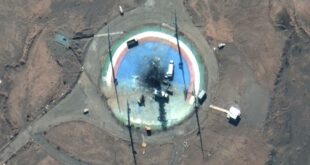 As part of the partnership between SpaceWatch.Global and the European Space Policy Institute, we have been granted permission to publish selected articles and briefs. This is ESPI Briefs No. 30: ‘The U.S. Space Force and the Rising Stakes for Europe in Space Defence ’, originally published in March 2019.
As part of the partnership between SpaceWatch.Global and the European Space Policy Institute, we have been granted permission to publish selected articles and briefs. This is ESPI Briefs No. 30: ‘The U.S. Space Force and the Rising Stakes for Europe in Space Defence ’, originally published in March 2019.
1. The U.S. Space Policy Directive 4

On 19 February 2019, President Trump signed the Space Policy Directive 4, directing the U.S. Department of Defense to deliver to the Congress a legislative proposal for the creation of a Space Force. This service, which will initially be integrated within the Department of the Air Force, will “organize, train and equip military space forces of the United States” and “ensure that needed space capabilities are integrated and available to all United States Combatant Commands”. The Space Force would have the mission to ensure “unfettered access to, and freedom to operate in, space” for the United States and its allies, deter aggression and defend their interests from hostile acts in and from space and project military power in, from, and to space in support of these interests.
In addition, the directive also re-establishes a U.S. Space Command to lead space warfighting with forces provided by the U.S. Space Force and other U.S. Armed Forces. By moving space operations from a support function to a fully operational role, this decision “reflects the importance of warfighting in space”.
2. A directive embedded within a broader change of U.S. posture…
The Space Policy Directive 4 is actually part of a broader move of the Trump administration to adapt U.S. Armed Forces to a changing military space landscape and achieve space dominance and control.
Apart from the Space Force and Space Command initiatives aforementioned, the United States is also seeking to improve and streamline its acquisition process to foster innovation, responsiveness and efficiency. This objective stimulated the creation of a Space Development Agency in March 2019, with the responsibility to unify the various space defence programmes and accelerate technological developments by reducing R&D time cycles and encouraging the integration of commercial solutions.
Eventually, the whole spectrum of U.S. space defence activities will be overhauled in the months to come, from Research, Development and Acquisition (Space Development Agency) to Operations (U.S. Space Force) and Command (U.S. Space Command). The administration requested $72.4 million for the establishment of the Space Force, $83.8 million for the Space Command and $149.8 million for the Space Development Agency. Overall, the reorganization of the U.S. space military sector would thus cost $306 million as part of Fiscal Year 2020. Interestingly, although the space force captures much of the attention, Patrick Shanahan, Acting Secretary of Defense, recently explained that the inauguration of the U.S. Space Command and Space Development Agency are actually more urgent than the creation of a Space Force, which still needs to be approved by the Congress.
Beyond the intent to optimise the functioning of national organisations, these recent decisions also illustrate a changing posture of the United States in the field of military space. Indeed, even if some of the proposed changes build on the legacy of previous administrations (e.g. the Space Command already existed until 2002) or are not as ambitious as initially planned (e.g. the Space Force is not yet an independent department), they form part of a broad move toward a more open and assertive stance of the United States in the rising context of a space “security dilemma”.
3. …and an evolving global space defence landscape
The U.S. space military reorganization should be understood within a fast-changing geopolitical and technological context.
Rising tensions and changes in the balance of power are reviving a new great power competition era, crystallised in the space domain and deeply impacting the global space arena: after having been the undisputed leader in space for decades, the United States is now witnessing the emergence of new powers, including in particular China. As a result, the country feels challenged in its capacity to maintain its leadership. This perception has already been translated, through successive Space Policy Directives, in the space exploration domain (SPD-1), in the commercial domain (SPD-2), in the security and safety domain (SPD-3) and, ultimately, in the military domain with SPD-4.
In Security and Defence matters, the perception of a challenged leadership is further amplified by the impression of an increasing vulnerability of critical space systems threatened by new military capabilities. Space assets have become core targets and an increasingly diverse and sophisticated arsenal of anti-satellite technologies (ASAT) is now available to a higher number of actors (as illustrated by the recent successful ASAT test conducted by India). Beyond “traditional” threats, some technological developments (i.e. in-orbit operations, active debris removal) are also nurturing concerns over dual-use “dormant” systems and fears of a “Space Pearl Harbour” with disastrous consequences for national security, economy and society.
Today, many other space-faring nations, including European countries, share these concerns and seek to better defend their space systems against potential hostile acts.
4. Rising stakes for a European Space Defence Policy
Regarding defence matters, Europe has not yet fully moved beyond the long-established and broadly agreed use of space resources in support to military operations on the ground. Over the last few years, anti-satellites systems have been subject to spectacular technological demonstrations by various space players. Together with the critical reliance of many European public policies on vulnerable space infrastructures, this will soon call for further discussions on potential consequences for the European Space policy.
For the time being, defence-related matters are the exclusive responsibility of Member States and some initiatives are considered – essentially on a national basis – to face the increasing challenges to the security of space assets. However, a Europe-wide approach will soon become a necessity given the high degree of integration and pooling of resources, notably in the framework of EU flagship programmes like Galileo, Copernicus and possibly Govsatcom and SSA in the near future.
Although it seems out of reach in the short term, a European Space Defence policy should be established in the future. To this end, some prerequisites could certainly start being reflected upon:
– Definition of a shared doctrine or strategy among European Member States to identify the threats,
– Setting up of a European Space security policy meeting the requirements of such a strategy,
– Assessment of the resources necessary for the implementation of such a policy,
– Joint reflections on a possible operational framework for the decision-making and management of the related activities,
– Definition of an appropriate legal/regulatory regime.
Such reflections should build on existing building blocks such as EEAS or PESCO, which provide an adequate overarching framework for the management of further defence-related developments. However, the most critical issue will, without any doubt, lie with the level of integration likely to be agreed upon by the various European Member States, among which sensitivity to defence and security matters is not evenly shared at the moment.
Rights reserved – this publication is reproduced with permission from ESPI. “Source: ESPI “ESPI Briefs” No. 30, March 2019. All rights reserved”
For more articles please visit ESPI website (www.espi.or.at).





